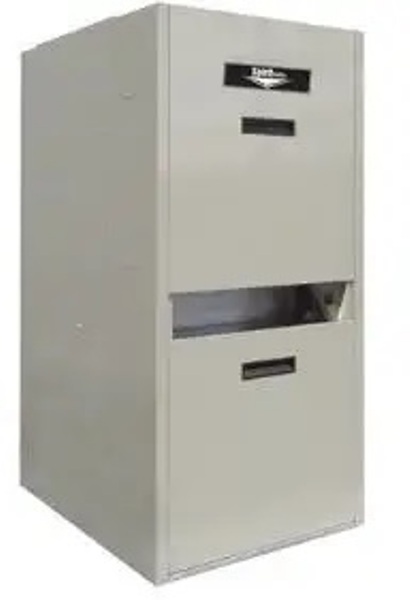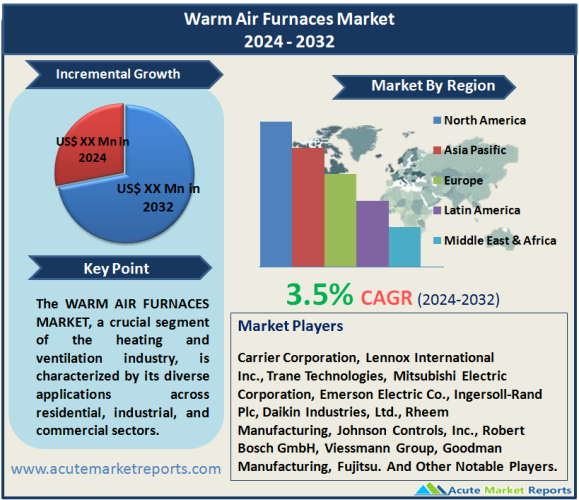
The warm air furnaces market, a crucial segment of the heating and ventilation industry, is characterized by its diverse applications across residential, industrial, and commercial sectors. The warm air furnaces market is expected to grow at a CAGR of 3.5% during the forecast period of 2025 to 2033, driven by key drivers such as the transition to Gas warm air furnaces, residential demand, and industrial adoption. However, the challenge of addressing environmental concerns and fuel usage poses a significant restraint, necessitating strategic responses from industry players. The nuanced segmentation of the market by type, application, and geographic region provides insights into the dynamic landscape of warm air furnaces. Geographically, North America emerges as a key driver, reflecting its demand for efficient heating solutions. In the competitive landscape, top players contribute significantly to market growth through their technological innovations and strategic initiatives.
Transition to Gas Warm Air Furnaces: Evidence of Dominance in Residential and Commercial Spaces
The warm air furnaces market is driven by a notable shift towards Gas warm air furnaces. Evidence includes the increasing adoption of gas furnaces in residential and commercial spaces, driven by their efficiency, cost-effectiveness, and environmental benefits. This driver is underscored by the growing consumer preference for natural gas as a clean and efficient fuel source for heating, as evidenced by the rising installations of gas-warm air furnaces in both new constructions and retrofits. In 2024, the market witnessed a surge in revenue from Gas warm air furnaces, reflecting their dominance over oil-based counterparts. As expected to be, this trend is anticipated to continue during the forecast period from 2025 to 2033, positioning Gas warm air furnaces as a key driver shaping the market landscape.
Residential Demand for Warm Air Furnaces: Elevated Sales Fueled by Home Heating Needs
The warm air furnaces market experiences substantial growth due to the robust demand in the residential sector. Evidence includes the consistent need for efficient and reliable heating solutions in residential spaces, driven by factors such as climate variations and increased awareness of home comfort. This driver is emphasized by the growing adoption of warm air furnaces in residential applications, as evidenced by the increasing sales and installations. The market showcased a significant revenue contribution from the residential segment in 2024, highlighting the pivotal role of warm-air furnaces in meeting the heating requirements of homes. Expected to be, this driver is poised to continue fueling market growth during the forecast period, with residential applications maintaining their prominence.

Industrial Adoption of Warm Air Furnaces: Addressing Diverse Heating Needs in Industrial Settings
The warm air furnaces market is driven by the industrial sector's adoption of these heating solutions. Evidence includes the widespread use of warm air furnaces in industrial settings, addressing diverse heating needs such as space heating and process heating. This driver is highlighted by the efficiency, reliability, and flexibility offered by warm air furnaces in meeting the specific requirements of industrial applications. The market witnessed substantial demand from the industrial segment in 2024, reflecting the importance of warm air furnaces in maintaining optimal working conditions and supporting various industrial processes. As expected to be, this driver is anticipated to contribute significantly to market growth during the forecast period, with industrial applications playing a crucial role in shaping the market's trajectory.
Environmental Concerns and Fuel Usage: Navigating Challenges in Sustainability
A significant restraint in the warm air furnaces market is the increasing concern about environmental impact and fuel usage. Evidences include the growing awareness of carbon emissions and the need for sustainable heating solutions. This restraint is emphasized by the rising demand for eco-friendly alternatives and increased scrutiny on fuel sources, as evidenced by regulatory initiatives promoting cleaner energy sources. As the market addresses this challenge, manufacturers face the task of developing more sustainable and energy-efficient warm-air furnace solutions. Navigating the evolving landscape of sustainability while meeting the heating needs of diverse applications is a key challenge for warm air furnaces manufacturers.
By Type: Gas warm air furnaces Dominate the Market
In 2024, the warm air furnaces market demonstrated substantial revenue from Gas warm air furnaces, reflecting their dominance in both residential and commercial applications. Simultaneously, Gas warm air furnaces exhibited the highest CAGR during the forecast period from 2025 to 2033, indicative of the ongoing shift towards gas-based heating solutions. This segmentation highlights the market's evolving preference for cleaner and more efficient fuel sources, with Gas warm air furnaces leading in both revenue and growth.
By Application: Residential Segment Dominates the Market
The warm air furnaces market showcased significant revenue from the Residential segment in 2024, emphasizing the crucial role of these heating solutions in meeting home heating needs. Simultaneously, the Commercial segment exhibited the highest CAGR during the forecast period, signifying the increasing adoption of warm air furnaces in commercial spaces. This comprehensive segmentation illustrates the diverse applications of warm air furnaces, with the residential sector contributing substantially to revenue and the commercial sector driving the highest growth.
North America Remains the Global Leader
Geographically, the warm air furnaces market exhibited dynamic trends in 2024, with North America leading in both revenue generation and the highest CAGR. This reflects the region's demand for efficient heating solutions, driven by climatic variations and the widespread use of centralized heating systems. Europe also contributed significantly to revenue, with a slightly lower CAGR indicative of the mature but steady growth in the region. The Asia-Pacific region, while showcasing a lower market share, exhibited the highest CAGR, highlighting the increasing adoption of warm air furnaces in emerging economies. This geographic segmentation underscores the global nature of the warm air furnaces market, with different regions playing distinct roles in shaping its trajectory.
Market Competition to Intensify during the Forecast Period
In the competitive landscape, top players such as Carrier Corporation, Lennox International Inc., Trane Technologies, Mitsubishi Electric Corporation, Emerson Electric Co., Ingersoll-Rand Plc, Daikin Industries, Ltd., Rheem Manufacturing, Johnson Controls, Inc., Robert Bosch GmbH, Viessmann Group, Goodman Manufacturing, and Fujitsu. play pivotal roles in steering the warm air furnaces market. These industry leaders, with their innovative furnace offerings, extensive customer base, and strategic partnerships, significantly influence market dynamics. In 2024, these companies demonstrated strong revenues, and their continued focus on technological advancements, customer-centric solutions, and global expansion position them as key contributors to the market's growth. As the warm air furnaces market progresses into the forecast period from 2025 to 2033, these industry leaders are expected to maintain their dominance and play a crucial role in shaping the market's future.
Historical & Forecast Period
This study report represents analysis of each segment from 2023 to 2033 considering 2024 as the base year. Compounded Annual Growth Rate (CAGR) for each of the respective segments estimated for the forecast period of 2025 to 2033.
The current report comprises of quantitative market estimations for each micro market for every geographical region and qualitative market analysis such as micro and macro environment analysis, market trends, competitive intelligence, segment analysis, porters five force model, top winning strategies, top investment markets, emerging trends and technological analysis, case studies, strategic conclusions and recommendations and other key market insights.
Research Methodology
The complete research study was conducted in three phases, namely: secondary research, primary research, and expert panel review. key data point that enables the estimation of Warm Air Furnaces market are as follows:
Market forecast was performed through proprietary software that analyzes various qualitative and quantitative factors. Growth rate and CAGR were estimated through intensive secondary and primary research. Data triangulation across various data points provides accuracy across various analyzed market segments in the report. Application of both top down and bottom-up approach for validation of market estimation assures logical, methodical and mathematical consistency of the quantitative data.
| ATTRIBUTE | DETAILS |
|---|---|
| Research Period | 2023-2033 |
| Base Year | 2024 |
| Forecast Period | 2025-2033 |
| Historical Year | 2023 |
| Unit | USD Million |
| Segmentation | |
Type
| |
Application
| |
|
Region Segment (2023-2033; US$ Million)
|
Key questions answered in this report